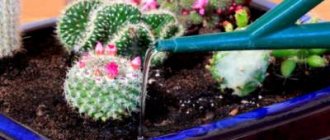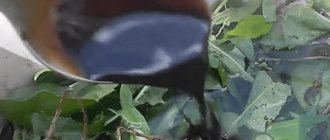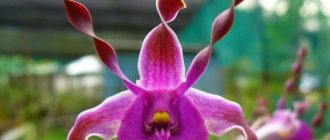Orchid is one of the most popular house plants . It has earned popularity due to its unpretentiousness and beauty.
Below is information about watering, because good and proper watering of orchids will allow you to see them bloom.
The orchid
has been famous for a long time :
- For more than 3000 years it has already been known, popular and loved;
- Medicines and love potions from it It is still used in medicine today;
- The nutritional value of some species is also known. I’ll just name vanilla;
Orchids grow in many countries. - For centuries, an orchid has been one of the best and most expensive gifts;
- Under natural conditions it grows on all continents. Except Antarctica . In the tropical zones of Southeast Asia, South and Central America, and the northern part of Australia, they grow most naturally;
- And it has gained well-deserved popularity these days. There is an opinion that in our country this is only the beginning of its popularity.
Let's find out in more detail below whether it is possible to water an orchid with ordinary water and what different watering methods exist.
General provisions for plant moisture
Is it possible to water an orchid from above? For many gardeners, the question of how to water correctly is similar to the question of how many times to water . Every day. In one day. 2 times per week. Under natural conditions, the regulation of watering does not depend on the plant. It rains often and a lot.
What can you offer to a representative of the tropics in an apartment or private house? Only after becoming familiar with the characteristics and advantages of your pets will you plan your actions.
So take into account some of their nuances :
- Orchids such as Miltonia, Paphiopedilium, Phalaenopsis, Cymbidium prefer soil mixtures when wet. Before watering. And do not allow the substrate to dry out;
- A whole group of orchids feels more comfortable if the soil dries out completely. Let it be for a while. But they must remain without moisture. And immediately there is an increased interest in these types of individual gardeners. Even if you missed it a little, it turns out it’s not scary, but even useful. These species are : Odontoglossum;
- Dendrobium;
- Cattleya;
- Oncidium (and its hybrids).
- Temperature;
- The approach must be individual. But the main criterion is soil condition. So experts give recommendations for all orchids with a gap. In summer - from 1 to 3 times a week. During the rest period - 2-3 times a month;
When watering orchids, you need to take into account their characteristics.
- Spraying the roots;
Orchids can be watered in the evening.
Attention! Experts give preference to morning watering. By evening the plants dry out. Not everyone has time in the morning. And you can water it in the evening. If there is a small temperature difference.
How to determine if an orchid needs watering
All orchids prefer a semi-dry substrate, so watering should be done only after the soil has dried.
By root color
This method is used when growing phalaenopsis. A change in the color of the roots indicates the need for watering. A signal that the soil needs to be moistened is the whitish or bluish color of the roots. It is very convenient to grow the crop in a transparent pot. The roots and their color are clearly visible through the plastic - you can easily determine whether you should water or not.
By the presence of condensation in the pot
If there is condensation on the walls of the pot, you should not water it. The next moistening of the substrate is carried out only after the walls of the container have completely dried.
By pot weight
Experienced gardeners determine the need for moisture by weighing the pot. They take it in their hand. A pot with dry substrate is much lighter than a container with wet substrate.
On a skewer inside the pot
Another fairly effective method of testing soil moisture. You will need to remove the top layer of the substrate and insert a skewer deep into the roots. After 15 minutes you should take it out. If the stick is dry, watering is needed; if it is wet, moisturizing is not required.
During budding
The flower spends a lot of its energy on the formation of buds. At this time, it requires enough moisture so that the plant can regain its strength.
During flowering
During flowering, watering is increased. During this period, the stems and leaf blades are filled with moisture. It should be ensured that the substrate is loose.
Orchids do not like excess moisture. Many species react to excessive humidity by dropping flowers.
Watering methods
It is quite difficult to arrange tropical rain in an apartment or even a greenhouse . Knowing the types of orchids you have will help you choose the most appropriate watering option. And the features of caring for them.
Advice! You can alternate watering methods (immersion, watering from a watering can).
Dive
- This method allows you to saturate all parts of the root system with moisture. Provides access to all its parts: Be selective about the time the plant is in water;
- Containers of different sizes;
- Young plants;
- Different stages of orchid development.
- Prepared water is poured into the basin. You can also add fertilizers to its composition (if it’s time to feed);
watering with this method with smaller containers . So that they can add water to large pots.
From above from a watering can
Is it necessary to water an orchid from above using a watering can? This method is used quite often :
- Place the flower pot on the grill. In the bathtub or basin;
- prepared warm water over the edges of the container . Small doses and a weak stream. Until you see water pouring out of the bottom holes of the pot;
- The water is drained from the pan;
- Careless watering can lead to moisture getting on the leaves and in their axils. They all need to be carefully removed with a napkin. And dry the plant;
- Depending on the condition of the soil, a repeated procedure . In 40-45 minutes. The roots do not always have time to absorb moisture.
Hot shower
Some gardeners use hot water irrigation:
- A warm shower is not needed. And warm (40-50 degrees) and soft water is needed. It creates the feeling of tropical rain. Stimulates the growth of foliage and subsequent flowering : Place containers with orchids in the bathroom;
- This should be done through a sprayer (shower head) and low water pressure;
- Determine the duration of watering based on the condition of the substrate. Half a minute is enough even for large containers;
- They should stand for about 15 minutes to allow the water to drain;
- If the soil is not saturated in one go, repeat the shower for the plant.
Attention! You can also use a watering can with a spray nozzle to organize your shower. If tap water is not trustworthy. Avoid hot showers in winter. The temperature difference is too great.
Spraying the roots
- Spraying of the roots is carried out on hot days . It's more comfortable for the plants in the morning. Some species require this to be done 2-3 times a day;
- It is simply necessary for plants placed without soil on blocks and in baskets. Their roots dry much faster on such structures than in pots;
- It suits Vandams very well. Their long and thick roots seem to be specially created for such watering . And it’s not very convenient to remove such huge plants for other methods;
- In winter, at low temperatures, this method is used very carefully ;
- For spraying, choose a good spray bottle. So that the dispersion is of high quality. In the form of fog. This should not be done from close range.
Important! Do not spray after fertilizing.
Through the pallet
- This method is used to water many types of flowers. The plant receives moisture from the roots located below;
- The main question. What kind of tray does your orchid have? Many gardeners install transparent containers in pots with a raised bottom in the middle. There is somewhere for excess moisture to drain. Their evaporation until the next watering maintains a humidified climate. Excess can be drained;
- It must be taken into account that the upper roots cannot always receive such moisture;
- As a type of such irrigation. Use a more intensive option . Spilling water. From a watering can or tap. Its purpose is to remove fine salts and dead particles with running water;
- Do not water the flowers. They may fall off;
- Place the plant on grates to allow excess moisture to drain out . For 30 minutes;
- Wipe the leaves and stems with a napkin. Take special care to remove moisture from the leaf axils.
How to properly water an orchid at home
Exotic butterfly flowers need watering only after the soil and roots dry out. If the grower clearly sees that the root system has dried, you can wait a couple more days to be on the safe side. Orchids are not afraid of short-term drought. How quickly the substrate dries depends on the weather and room temperature. In summer, the soil can dry out in 2 days, in rainy weather - in a week. In winter, when the plant is kept in cool conditions, the substrate moisture is retained for a very long time.
What kind of water should you water your orchid with?
To water representatives of the Orchid family, you should not use tap water. It contains chlorine, which can negatively affect the development of the plant. It is better to use distilled water.
The main thing is that the water should be at room temperature – +32-35°C. The next watering should be done when the substrate has dried well. The ideal soil for orchids contains tree bark. Fine gravel or expanded clay is used as drainage. This composition promotes good breathability, as a result of which excess moisture quickly evaporates.
Many novice gardeners cannot decide on a schedule for watering orchids, which is why they suffer. Lack and excess of moisture leads to sad consequences. As a result, the root system may die.
How often to water an orchid
When growing orchids, it is important to adhere to certain watering rules.
- The next moistening of the substrate is carried out only after checking the dryness of the soil, and not only the surface layer should be dry, but also the middle one. A transparent container will help you visually determine how dry the soil is.
- When growing an orchid in a plastic pot, condensation collects on its walls. You should not water again until this condensation disappears.
- The color of the root system also signals the need for watering. If the roots are bright green, there is no need to water. Coloring the roots light yellow indicates that the plant needs watering.
To determine the humidity of the substrate in an opaque pot, use the following method. It is necessary to remove the top layer and deepen it with a match or toothpick. After 15 minutes, take it out and look at its condition. If a match or toothpick turns out to be wet, you should wait to water it.
In summer it is recommended to moisturize the shoes once a week, in winter – once every 2 weeks. If there are differences in day and night temperatures in the room, the number of waterings should be reduced.
If the flower is over-watered, it will die due to rotting of the root system.
All orchids, regardless of the variety, are watered only after the substrate has completely dried.
The influence of lighting and temperature during watering
If an orchid grows in a room where the sun shines through the windows, the substrate dries out very quickly. Frequent watering is required. In winter, the length of daylight hours decreases and the temperature drops, so the soil in the pot remains moist for a long time. Every gardener knows the temperature conditions well and must adapt to them.
When the exotic plant is at rest, it is recommended to minimize the amount of irrigation. During active growth and flowering, frequent moistening is necessary.
In cloudy weather, moisture evaporates less, so sufficient time should pass between waterings. It is forbidden to spray an exotic butterfly while the peduncle is growing, as it may rot.
The influence of time of year on watering
The time of year directly affects the amount of watering performed. For many types of orchids, a dormant period begins in the fall and continues until mid-winter. At this time, you need to water no more than once every 10 days. During the period of active growth, the frequency of watering increases significantly. When the orchid blooms, watering should be once every 3 days.
Watering orchids after transplantation
The frequency of watering for representatives of the Orchid family depends on the substrate used for planting the crop.
- If the transplant was carried out in ready-made soil, after a day the orchid should be watered a little.
- When using an independent collection that contains sphagnum moss, the substrate must be moistened before planting the plant in it. Subsequent watering is carried out no earlier than after 2 weeks.
- If the children were separated from the mother plant, then they should be watered the very next day. The fact is that the root system of the babies cannot fully provide them with nutrients, so they cannot survive without moisture.
As soon as the children take root (14 days have passed), they are watered in the same way as adult specimens.
Watering an orchid during flowering
During the period of bud blooming, the frequency of soil moistening should be increased. At this time, the stems and leaves intensively use water. You should know that the substrate must be loose to ensure good air and moisture permeability. In such soil, water will not stagnate.
The orchid does not like strong drying, but it will not live long with “wet feet”. Therefore, culture needs a golden mean. The substrate should dry well between waterings.
Excessive moisture can lead to the dropping of buds and rotting of the roots.
Note!
1. A hot shower is undesirable if the room temperature is low or high, and the room is closed and has poor air ventilation. If the air does not circulate well, the humidity rises, and after a hot shower, the substrate and wet plant leaves will evaporate additional moisture. This can provoke bacteria, mold, viruses and other fungal diseases at both high and low air temperatures.
2. If care is not taken carefully after a shower, moisture may stagnate at the growing point of orchids and, as a result, wet rot; this problem does not apply to most other indoor plants.
3. The main contraindication for using a hot shower is the presence of rot developing in any part of the orchid.
We have discussed all the pros and cons of using a hot shower, but it’s up to you to decide whether to use this watering method or not!
What fertilizer is needed for orchids?
For root feeding during the growth of leaves and roots, as well as for young plants, we recommend using the universal fertilizer “Mr. Color - Universal” in a concentration of 1 cap per 3 liters of water, and for planting flower stalks and during the flowering period - a special fertilizer for orchids - “Mr. color - orchid" in...
Interesting materials:
How to hire a citizen of Kyrgyzstan in 2022? How to hire a citizen of Moldova? How to hire a foreigner in Ukraine? How to get hired for a part-time job? How to hire a previously fired employee? How to hire a part-time worker at 0-5 rates? How to hire an external part-time worker for your main job? How is an employee hired? How do you get hired for a job with a probationary period? How to hire citizens of Kyrgyzstan?
Secrets and tips
For a comfortable existence, orchids require moderate (even balanced) watering. Without moisture they will simply die, but too much moisture will destroy the plant. Focus on the color of the phalaenopsis roots - this is the surest signal that will never let you down. Never leave drops of water on the orchid leaves. In hot weather, water it more often and more abundantly, and in the cold season, spray it better.
Lack of moisture is detrimental to orchids mainly during bud setting, and waterlogging is detrimental to orchids at any time. A “flooded” orchid will certainly begin to rot its roots, and the substrate in the pot will become moldy. At the first such symptoms, the plant should be immediately transplanted into a new pot, replacing the substrate in it and cutting off all damaged parts of the roots.
So be careful and moderate in your desire to actively care for the flower. Remember that the main motto of a skilled “irrigator”: it is better to underfill than to overfill. The phalaenopsis orchid prefers proper watering, corresponding to the “water regime” of its native habitats. And in its native places it takes moisture mainly from the air. And if you follow all the rules and requirements (dictated, by the way, by the orchid itself), then your Tropicana will definitely thank you with its magical blooms.
Why do potted plants need a hot shower?
Any activity when growing indoor flowers is aimed at improving the appearance and health of plants. A hot shower is no exception. Hot water cleans the surfaces of sheet plates much better than cold water.
Many gardeners use hot showers in the following cases:
- how to prevent diseases
- as a therapeutic procedure for certain diseases
- for healthy leaves
- for cleaning leaves and shoots when heavily soiled
- to stimulate flowering
- How to prevent leaf deformation
- to speed up leaf growth
- as shock therapy for dying plants
- how to prevent the appearance and reduce the number of pests
It is important to remember that even the most beneficial measure is not suitable for all plants.
Hot showers are contraindicated:
- newly transplanted plants
- plants that are dormant
- flowering plants during the period of abundant flowering
- plants whose leaves have dense pubescence
When taking a hot shower, you need to consider:
- plant age
- size of leaves and height of shoots
- whole plant size
- condition and life cycle
- season
- Times of Day
Flowers, like people, require an individual and reasonable approach, adherence to measures and a certain technique.











